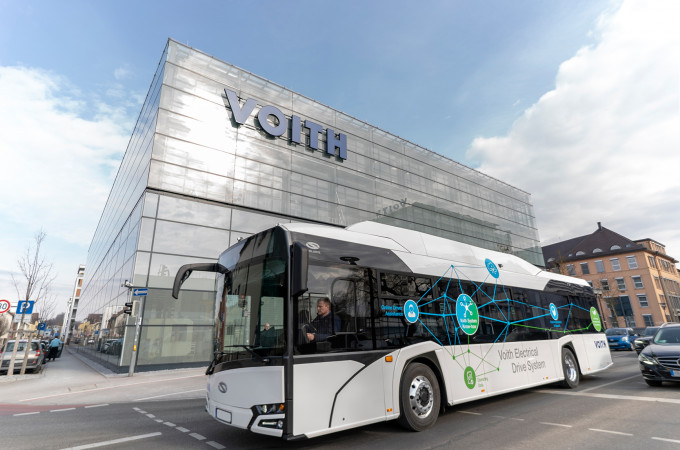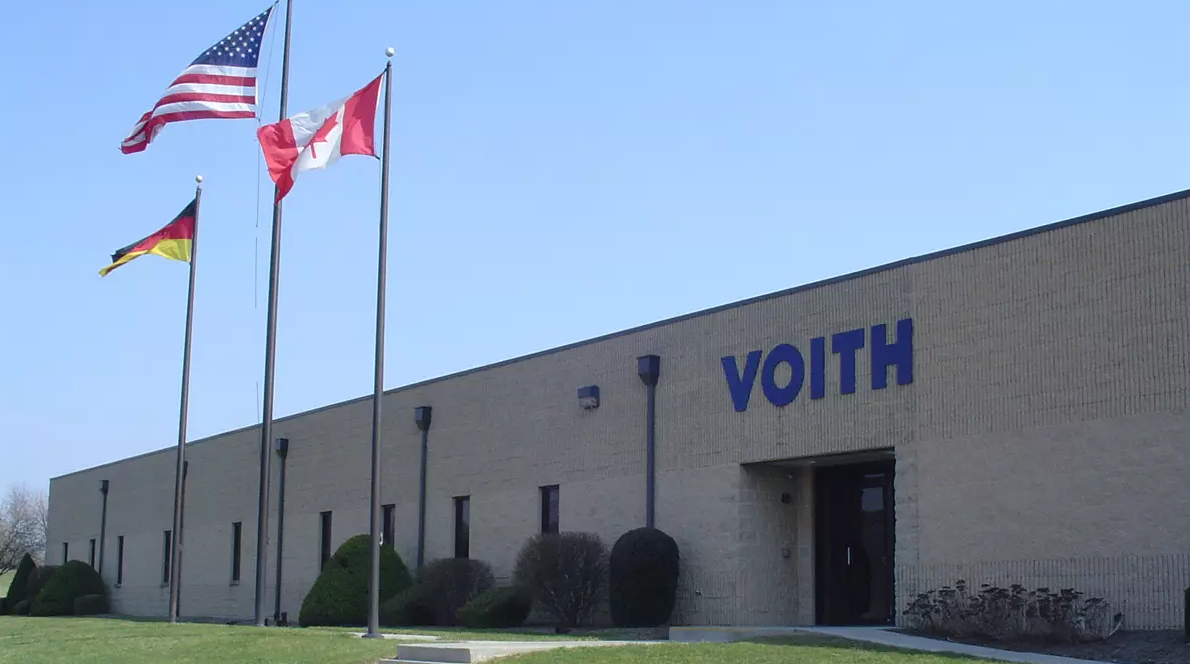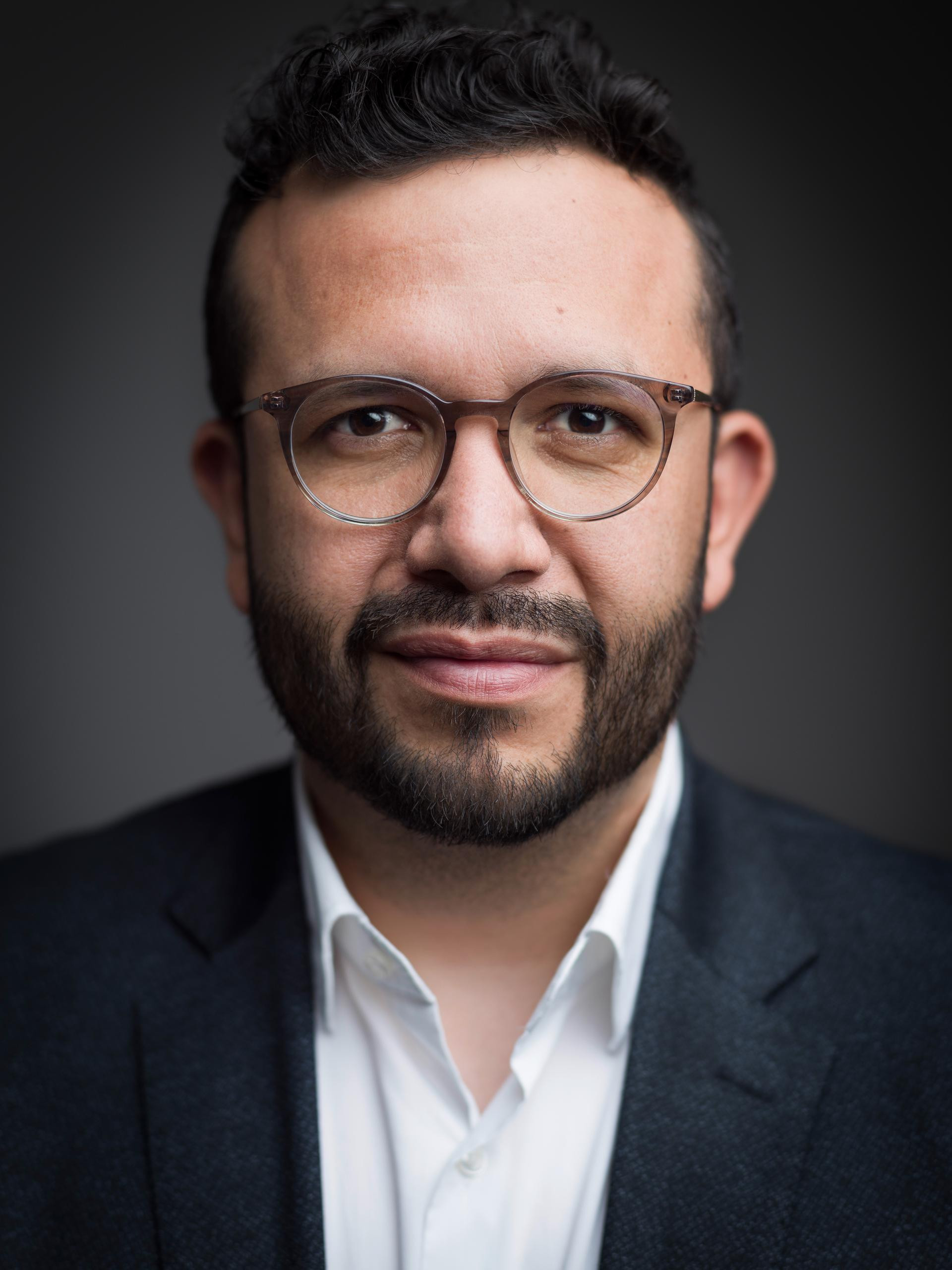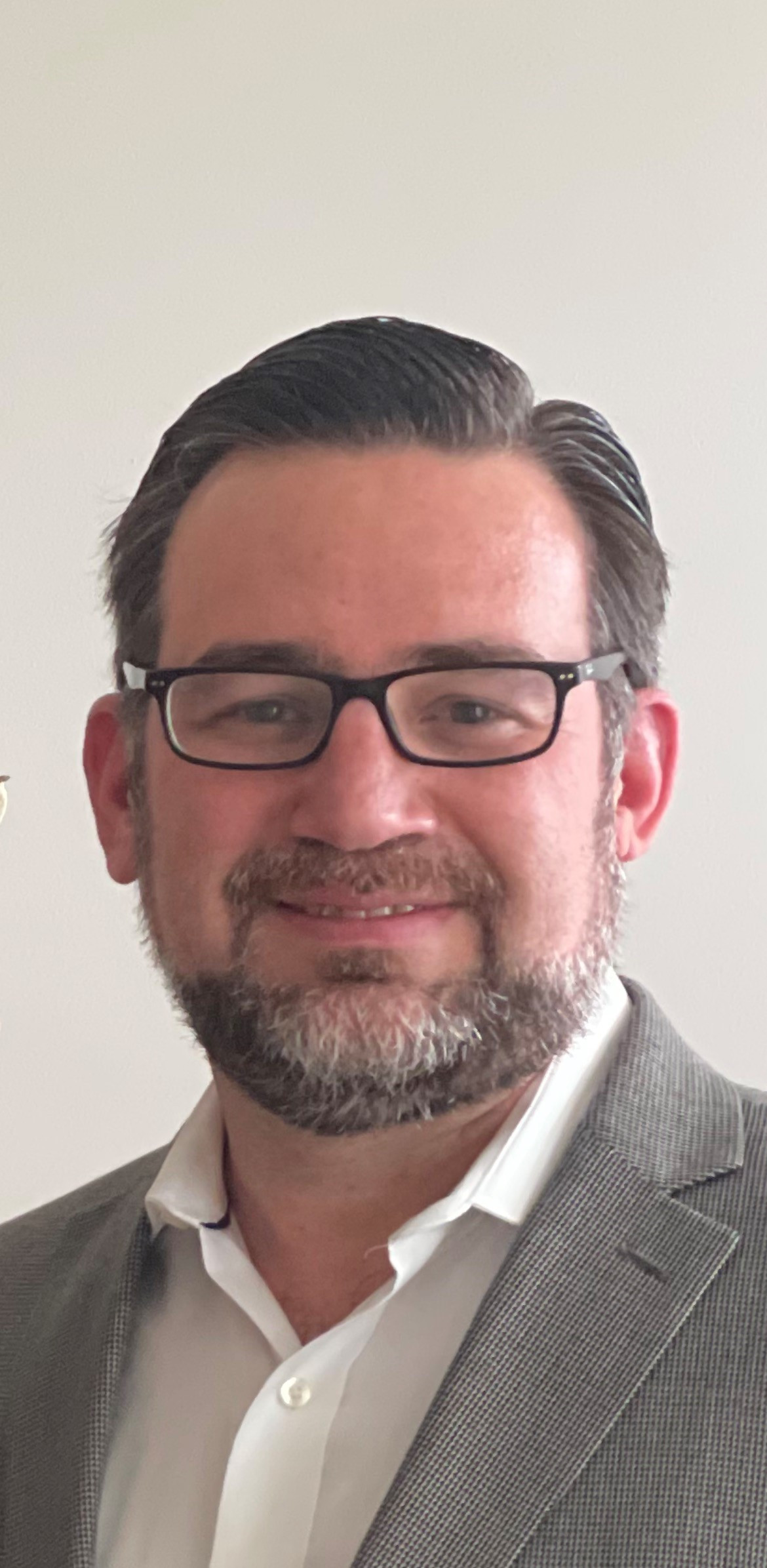Riding the second wave: Voith Turbo’s North American EV strategy
By Bradley Osborne - 5th December 2023

Voith VEDS demonstrator in Heidenheim, Germany
Germany / North America – The market for electric vehicles in North America is currently a very crowded one. In the wake of two crucial U.S. government bills – the Infrastructure Investment and Jobs Act (2021) and the Inflation Reduction Act (2022)1 – established OEMs and startups are enjoying a boost in interest as grants and tax incentives support the expansion of EV manufacturing, sales, and charging/fuelling infrastructure. On paper, the government support for EV production and adoption should put the market on a solid foundation; but market predictions are very tricky to make. In any case, many different players are crowding – some might say, oversaturating – the market to get a piece of the action while the money is still available.2
We will not see Voith rushing into the mix anytime soon. As Manuel Calero, Vice President for e-mobility, told T&BB in a recent interview, the first wave of electrification is over, and the North American manufacturers have already teamed up with other powertrain suppliers for their first-generation EVs. But “they’re looking now,” said Calero, “for the second wave, for the better solutions.” This is where Voith believes it can come in with its own e-powertrain offering, proven over many years of customer pilots and orders in Europe to be efficient and reliable.
During our discussion of Voith Turbo’s USMCA3 strategy, the conversation revolved around the differences between the North American and European CV markets and the challenges which the German company will face in carving out a share of the North American market. Voith is no stranger to the continent, having supplied components to the truck and bus segments for more than 35 years, but it worked extensively with domestic partners such as Cummins to achieve its North American foothold. Nowadays, Cummins is no longer an ally but a competitor in the e-powertrain market. Nevertheless, Calero is optimistic about Voith Turbo’s chances: “We need to have the right confidence, and we have it with our product, in order to offer customers something which has a clear advantage over established competitors.” The company is using its contacts in North America to communicate the unique strengths of its electric drive system, with the aim of launching a sales and operations planning process by 2025.
The Voith group first made a name for itself in North America not through its Turbo division but through hydropower. Its history in the U.S. dates back to 1877 and includes the legacy hydropower companies of Siemens, Westinghouse, Allis Chamers, and S Morgan Smith. In the early twentieth century, Voith Hydro won a contract to supply twelve spiral turbines, each capable of delivering over 12,000 hp, to the Ontario Power Company at Niagara Falls. Voith Hydro’s North American base was in York, Pennsylvania, and it was in York that Voith Turbo elected to set up its business operations. Beginning in 1975, Voith Turbo began supplying its DIWA automatic transmissions to the transit bus segment, and today it holds approximately 25% of the market. Luiz Soares – Director of Sales KAM-CV, e-Mobility and Business Development in North America – told T&BB that amongst the largest DIWA fleets, there are 800 buses in both Portland, Oregon and Pittsburgh, Pennsylvania running today with Voith transmissions, and about 600 in Los Angeles, California.
Voith Turbo now has seven offices across the continent, including the York headquarters: one in Panama; two in Canada (Mississauga, Ontario and Calgary, Alberta); one in Houston, Texas; one in Sacramento, California; and one in Mexico City. Voith’s customers include the majority of the major American bus brands, and while its presence in the truck market is smaller, Voith is also a major supplier of compressors, turbo-compound components, and – in Mexico exclusively – retarders.

Voith North America headquarters in York, Pennsylvania
Voith’s approach to the North American EV market
When supplying components to North American manufacturers of conventional trucks and buses, Voith Turbo has invariably exported parts straight from its production sites in Europe. Only with peripherals – for example, cables and flanges in its DIWA transmissions – has it opted for local content in its products for the North American market.
This approach to business will need to change. Attached to federal and state governments’ generous funding packages and tax breaks in the United States are so-called “Buy America” requirements, meaning that electric vehicles which lack sufficient content made in the USA do not qualify for incentives. For example, EV buses sold today need 70% of the value of their components to be derived from the USA in order to comply with Buy America. Presently, the battery manufacturers are bearing the brunt of such requirements, as they supply what is by far the costliest part of the EV. But as batteries get cheaper, the burden of compliance will shift increasingly to other parts of the powertrain, including the parts (motor, transmission, inverter, etc.) which companies such as Voith will supply.
As part of its North American strategy, Voith Turbo will inevitably have to face up to the issue of supplying local content to its customers. Calero put it succinctly: “The OEMs want to be Buy America compliant, otherwise they cannot sell their vehicles, because the operators are looking for funding and they can only get funding by being Buy America compliant.” His view is that, at some point in the foreseeable future, the company will need to build a plant on American soil for component assembly. But Calero does not envisage making everything in the USA. As far as its electric drive system is concerned, the strategy will be to focus on those parts which can be localised quickly. The first such to be made locally will be the inverter, Calero told T&BB, and more parts will follow.
Buy America requirements do not exclusively apply to the commercial vehicle industry. Voith’s other businesses are having to adapt to the new market context as well. As in the past, Voith Hydro is leading the way in North America, with nearly USD20m earmarked for investment in its manufacturing facility in York. Voith Turbo’s rail division is also investing a considerable amount already, with a USD5m expansion of its York workshop having commenced in August. Its e-mobility division is sure to follow in their footsteps with its own investments. Even without Buy America, there are advantages to having local production for local sales (or “local-for-local”). Calero said:
The pressure on pricing is increasing. The securitisation of the supply chain is one of the key components of the business now. And I’m convinced that localisation is one of the main drivers behind securing your business, remaining competitive and, on top of that, fulfilling Buy America requirements. So it is the combination of these three components which is leading anyhow to the business decision to localise as much content as possible, because it is not only about selling parts, it is about delivering them and being competitive on that.
As important as establishing local production is to Voith Turbo’s NAFTA strategy, the first step will be to find customers for its electric drive system. Calero told T&BB that the company is already in advanced talks with two “key players” in the North American market. As mentioned before, the OEMs have already partnered up with other suppliers for their first-generation electric vehicles, but now they are looking for a differentiator which will give their second-generation vehicles the edge over the competition. “We have the customers, the interest is there, they clearly recognise our unique selling points, and now it’s time to implement: to go into it, to build the first demonstrators, and based on the demonstrators, implement the platforms and fix the SOP [start of production],” said Calero.
Differences between the European and North American markets
Soares moved to the U.S. in 2015, starting as business development manager before transferring to his current role, leading truck and bus OEM sales in the North American market. He is therefore quite familiar with the workings of the CV industry across the pond. “You have a very closed transit bus industry [in North America],” he told T&BB. While there are some international connections through the NFI Group (its UK subsidiary, ADL) and Nova Bus (owned by Volvo), the bus industry is primarily made up of local manufacturers making vehicles for local customers. The truck industry presents a slightly different picture, with greater involvement from Volvo and Daimler Truck (who own Mack Trucks and Freightliner respectively). Even so, the North American truck manufacturers predominantly make use of options from Tier 1 suppliers – Cummins for engines, Allison or Eaton for transmissions – in marked contrast to the in-house development which is the norm for European trucks.
What this means, according to Soares and Calero, is that North American OEMs tend to ask more of their suppliers than their European counterparts do. The former do not necessarily have the “complete engineering teams” required to integrate complex powertrains with their vehicle platforms, whereas the latter do. “In the U.S.,” said Calero, “we clearly need to do more than in Europe, and that’s something we needed to understand, we need to do more as a supplier.” Supplying a part or a system off the shelf, as it were, won’t work as well in North America: Voith Turbo will need to work on each platform together with the OEM, implement the right solution, and then release the system together with the OEM in order to establish business.
Voith Turbo has extensive experience and an established market presence in the North American bus segment. However, the electric truck market appears to be especially promising. It is, in Calero’s estimation, “less consolidated” than the electric bus market. E-axles and central drives with transmissions are competing for supremacy, and the door is open for the entry of a new offering, like the VEDS HD+ for heavy duty vehicles.4
Neither Calero nor Soares seem all that fazed by the potential risks and challenges they face. In terms of government funding, “no one can predict what would be kept and what would change” if a new administration were elected next year. They are alive to the risk this presents: there is a “lack of clarity” around what will happen if and when the funding stops, especially if it happens before cost parity between diesel and electric commercial vehicles is achieved. Soares travels regularly to California, which has led the way in legislating the switch to EVs, and he hears “more and more that the electric buses are arriving, and they don’t have anywhere to charge them.” There is a “bottleneck” in the transition, and it is not clear yet that the money which is already committed by federal and state governments will be enough to overcome it sooner rather than later.
On the other hand, this situation is not unique to North America. From the point of view of the OEMs and the Tier 1 suppliers – whose influence on the ebb and flow of high politics is minimal – the key is to be “where we need to be”, in a position to offer customers the best products possible, within the constraints of the place and moment.
1 See https://truckandbusbuilder.com/article/2022/08/31/us-government-allocates-usd-75-billion-in-funding-for-transit-sector-over-next-five-years for some background on the former.
2 The last ACT Expo in May 2023 was packed with commercial vehicle manufacturers, old and new, attempting to break into the EV market; the following report gives an impression of the flurry of activity happening in North America: https://truckandbusbuilder.com/article/2023/05/30/act-expo-2023-report
3 Referring to the trade bloc created by the signatories of the United States-Mexico-Canada Agreement, effective 1 July 2020.

After his studies in mechatronics, Manuel Calero held various positions in system engineering and development in the field of e-mobility. Most recently, as R&D Director, he was responsible for defining the product and corporate strategy within the high-voltage inverter sector as well as the positioning on the e-mobility market. In February 2023, he joined Voith Turbo as Vice President E-Mobility.

Luiz Soares is a materials engineer with more than 35 years of experience in the automotive industry. He joined Voith Turbo in Brazil back in 2001 and held several positions before moving in 2012 to lead the Commercial Vehicles and Rail teams of Voith Turbo’s brand in Mexico City. After more than 3 years there, he moved to the USA in a business development role to bring new Voith Turbo technologies to market. Today he is responsible for truck and bus OEM sales and the e-Mobility and Business Development for the Commercial Vehicles division of Voith Turbo North America.

